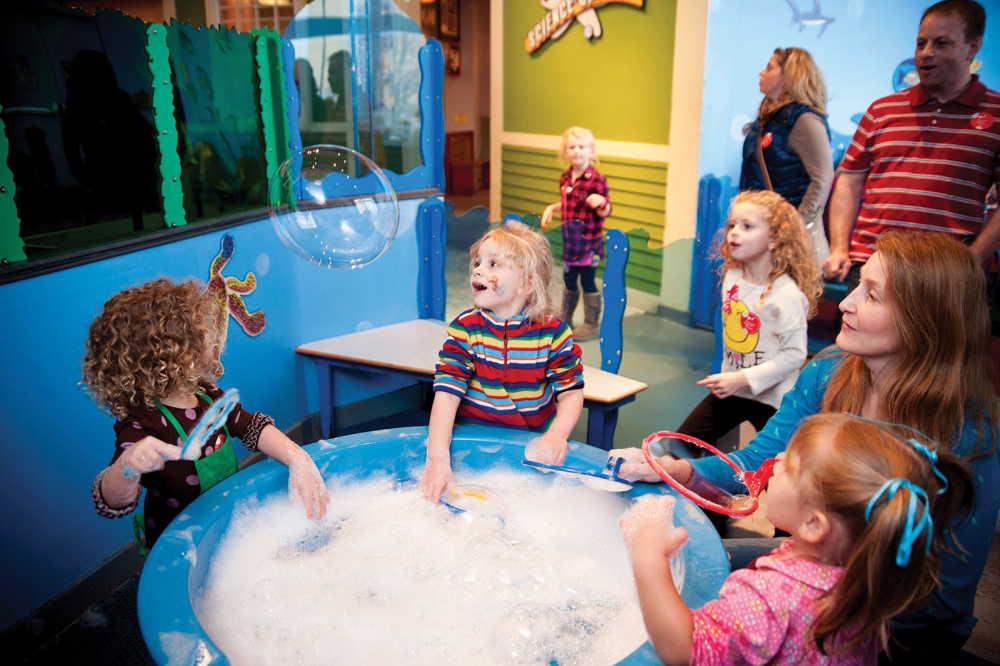Whenever I take my grandchildren to a children’s museum, they never want to leave. And why would they? There are more than 200 children’s museums in the United States, and they are happening places that delight children. They range from small one-room places to gigantic institutions with budgets in the millions. Each one is unique and appropriate for its community.
What is a children’s museum? Children’s museums are unlike most museums geared to adults. They are places to play, touch things, make things, and explore how things work. Children interact physically, intellectually, and emotionally with the exhibits or stations.
Young children can make boats travel down a “river” or rockets that climb high into the air. They can build pathways for marbles. They can drive fire engines or farm equipment. They can build houses and towns from foam blocks and other materials. They can write on old typewriters or weave or sew or dress up in costumes. They can learn about the unique characteristics of their own communities, and they can imagine and create new worlds.
Older children can play chess on a giant chess board or master a climbing wall or complete cutting edge projects in a makerspace. They can create music or films or kites or mobiles.
What would a children’s museum do for the upper Eastern Shore? It would help attract young families. It would stimulate tourism. It would provide both paid and volunteer jobs for adults and for high school and college students. It would complement the work of schools and parents in helping to raise curious, creative, competent, and confident young people.
Where would a children’s museum be located? It could be located in Chestertown or along the 301 corridor to attract visitors from Middletown as well as from other Eastern Shore counties. A warehouse space would be ideal. A vacant schoolhouse in Crumpton is a possibility.
Who would pay for a children’s discovery museum here? As a non-profit organization, the museum would qualify for grants, donations, sponsorships, memberships, and entrance fees.
A few principles might guide the development of a children’s museum here, including the following:
- Due to the relatively small population of children within an hour’s drive, our museum would need to appeal to a broad age range, from toddlers to tweens.
- Our museum would not compete with or try to duplicate the superb work being done by Echo Hill Outdoor School, the Sultana, the Sassafras Environmental Education Center, or other established programs for children.
- In addition to an adult board of directors, our museum would have a kids’ board of directors that would approve, and design and help build each station.
- Most stations would be fairly low-tech and inexpensive to make.
- The museum would build on local strengths, such as an outstanding retired volunteer community and a vibrant agricultural economy.
- The museum would be designed for ALL children, including those with disabilities.
For the last five years I have been visiting children’s museums in California, Delaware, Maryland, Pennsylvania, and Florida, sometimes with my grandchildren and sometimes just to observe what goes on. And for the last ten years I have supervised the children’s programs at Mount Harmon Plantation, which is a historic house museum in Cecil County. My takeaway observation from these experiences is that the expensive, high tech stations are not nearly as appealing to children as the simple stations in which children – not machines – make things happen. In many of the larger museums, children push a button and then run away before they see the consequence of pushing the button. The best children’s museums have adults around who can help kids make rockets out of construction paper and masking tape, or teach them to sew or weave, or explain the differences among rocks or shells.
Almost a generation ago, people in Kent County came together to build the Sultana. That project continues to transform Kent County in ways too numerous to recount here. We need a new project, one that will engage the unbounded creativity and talents of the people who live here.
From 6:00 to 7:30 pm on Tuesday, March 31, a brainstorming meeting will be held in the yellow building behind the Chestertown Library to ascertain if there is sufficient interest in building a children’s discovery museum here.
Wendy Costa serves of the Kent County Public School Board of Education. She can be reached at [email protected]



Karla Cherry says
4-H clubs already provide those same activities & are open to everyone. They just need to get involved!
Deirdre LaMotte says
When my children were younger we would love spending the day at Mt.Vernon…
lots of hands-on activities that spark the imagination. I remember how fun it was for them to sift through tables of colonial clothes and
play dress up. I really love this idea of a children’s museum as it enables children to tactically understand our world.
Elizabeth Hill says
Hello, I am Beth Hill, 4-H Educator here in Kent County. I am planning to be at this meeting. Ms. Cherry is correct, 4-H is a hands on experiential youth development program with a long history of teaching youth to “learn by doing”. I look forward to being a part of the discussion. Anyone interested in learning more about the Kent County 4-H program can contact me at [email protected], by calling the UMD Extension Kent 4-H Office 410-778-1661 or visiting us online at https://extension.umd.edu/kent-county